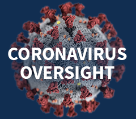Manufacturing:
Scaling Up Vaccines in Record Time
Challenges exist in ramping up vaccine manufacturing in such a short period of time. Here we explore those challenges and the steps the Department of Defense (DOD) and Department of Health and Human Services (HHS) partnership and companies have taken to mitigate them.

Facility constraints1
The production of vaccines requires specialized facilities and equipment. According to experts, even before the COVID-19 pandemic, most existing vaccine manufacturing facilities were already in use. We previously reported that new facilities had to be built or production shifted in order to meet this new need.

Image source: chrupka/stock.adobe.com
What’s more, once bulk quantities of vaccines are produced, they must be sealed into sterile containers, such as vials or syringes. We heard from industry groups that there was a shortage of facilities that can produce these sterile containers. Those types of facility shortages can lead to bottlenecks.
Supply shortages2
The pressures of the global pandemic have made it difficult to obtain materials needed for manufacturing. For example, we heard from representatives at one COVID-19 vaccine manufacturing facility that they experienced challenges obtaining materials, including disposable reactor bags, filters, and certain chemicals.
Representatives from that manufacturing facility told us that at one point they had to wait 4 to 12 weeks for items that were typically available for shipment within a week. We also heard from one expert that the supply of the materials used to make sterile containers, such as glass vials and pre-filled syringes, was limited, too.
Technology transfer3
Producing COVID-19 vaccines also requires specific knowledge—knowledge of the steps and the materials involved and knowledge that needs to be transferred across multiple manufacturing sites4.

Image source: Zubada/stock.adobe.com
This is a complex process that is especially difficult with new technologies, such as mRNA vaccines, where there is little experience in scaling up production. Additionally, disputes over intellectual property rights have the potential to further hamper the process. However, many vaccine companies we interviewed reported completing technology transfers at their large-scale manufacturing facilities.
Workforce gaps5
The skills required to produce these vaccines are complex, and hiring and training personnel to run vaccine production systems may be a challenge even for highly experienced manufacturers.
Indeed, one COVID-19 vaccine manufacturing facility told us that it has been a challenge to fill mid- to upper-management positions to oversee safety and quality.
Potential Choke Points in Scaling Up Vaccine Production Related to Key Manufacturing Challenges

The way forward6
Federal agencies and vaccine manufacturers are working to mitigate these challenges. HHS has announced awards to improve domestic manufacturing capacity.
Additionally, we heard from representatives of a COVID-19 vaccine manufacturing facility that DOD assisted them with expediting the delivery of critical equipment. HHS’s Biomedical Advanced Research and Development Authority (BARDA) also worked with vaccine companies to create a list of critical supply needs and identify common needs across the six vaccine candidates under the DOD and HHS partnership, according to officials. Officials also said BARDA is working with suppliers to ramp up production capacity for the materials identified as critical needs.
Further, to help vaccine manufacturers gain timely access to key materials and resources, DOD and HHS officials said they have prioritized supply contracts for vaccine manufacturers under the Defense Production Act. The act, as delegated, generally provides federal agencies authority to, among other things, place ratings on contracts so that they receive priority treatment over unrated contracts or orders if necessary to meet the delivery or performance dates specified in the order.
Taken together, these types of efforts will be critical as federal agencies and vaccine manufacturers work to produce a COVID-19 vaccine at record speed.
Footnotes
- Source: GAO-21-319
- Source: GAO-21-319
- Sources: GAO-21-207, GAO-21-319
- Source: GAO-21-207
- Source: GAO-21-319
- Source: GAO-21-319




